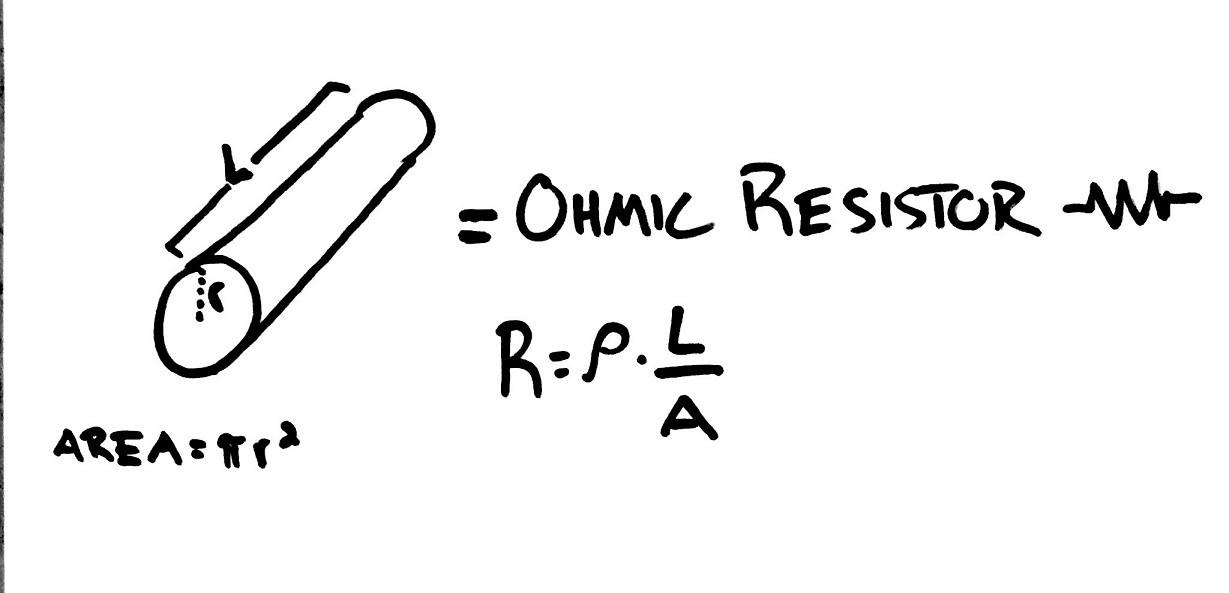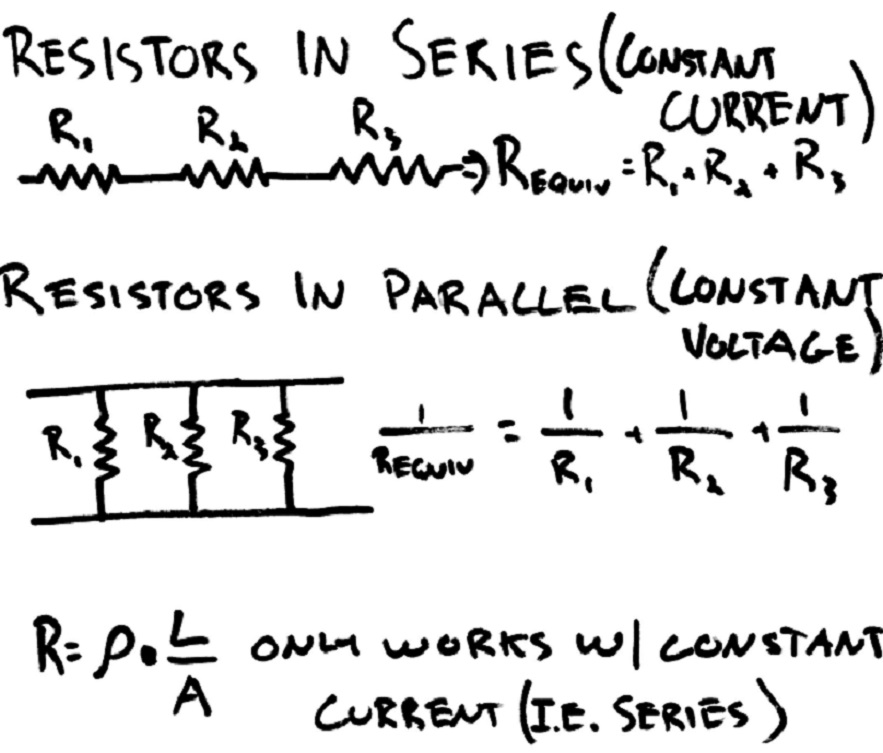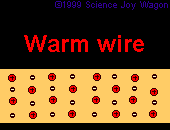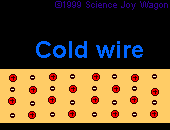Resistivity
Claimed by Brian Duffy -- Fall 2016
Resistivity is the measure of a specific materials ability to impede the flow of an electric current. The SI unit of resistivity is measured in Ohms per meter, ([math]\displaystyle{ ({Ohm}⋅{Meter}) }[/math] or [math]\displaystyle{ ({Ω}⋅{m}) }[/math]) and is used to determine the resistance of a given conductor. Resistivity of an object is almost entirely dependent on two specific factors: temperature and material. Resistivity is totally dependent of the shape or size of whatever material, which is different from overall resistance (which depends on resistivity, length and cross-sectional area of the object).
The Main Idea
Resistivity is essentially a constant that describes the resistability of a specific material with respect to the current that passes through it. Some materials will more readily allow the flow of current in comparison to others. For instance, copper has half the resistivity as that of aluminum. Thus, most wires are made out of copper instead of aluminum -- as aluminum impedes the flow of electrical current. Materials like glass, which are poor conductors usually have very high resistivity, and metals which conduct electricity well have much lower resistivity.
A Mathematical Model
Resistance is often calculated from resistivity using the following equation [math]\displaystyle{ R = \frac{\rho L}{A} }[/math] where R is the resistance [math]\displaystyle{ \rho }[/math] is the resistivity, L is the length, and A is the cross-sectional area. While the area of the wire or object may be variable, as well as the length, resistivity remains constant because the material remains constant.
In a circuit the Electrical Resistance is then used to calculate the current in a circuit using Ohm's Law and the following equation [math]\displaystyle{ I = \frac{|\Delta V|}{R} }[/math] where V is the voltage, I is the current, and R is the resistance. In this equations voltage and resistance are independent variables, whereas the Current is the dependent variable. This law, while useful, only works for ohmic resistors.
The definition provided above is specific to ohmic resistors, as stated. These resistors have a uniform cross-section, where current flows uniformly through them. Instead, a more general definition starts with the idea that an electric field inside a specific material is responsible for the electric current flowing within it. Because most of the resistors we will deal with are uniform, a simple ratio of field to current can be used in regards to resistivity. Thus, the electrical resistivity, or "p" can be defined as the ratio of the electric field to the density of the current it creates:
- [math]\displaystyle{ \rho=\frac{E}{J}, \,\! }[/math]
where "ρ" is the resistivity (ohm⋅meter), "E" is the magnitude of the electric field (volts per meter), and J is the magnitude of the current density (amperes per square meter).
Note, remember above where objects with higher resistance are worse conductors and vice versa; this can be seen when E and J are inside the conductor. Conductivity is the inverse of resistivity:
- [math]\displaystyle{ \sigma=\frac{1}{\rho} = \frac{J}{E}. \,\! }[/math]
Water Analogy
The relationship between resistivity and resistance can be thought of as a series of pipes. Electrical Resistance in a particular material is similar to an analogy of pipes of varying diameter. The larger the pipe the easier it is for water to get through. The resistivity of the "pipes" never change, but the cross sectional area does, in order for the facilitation of "water" flow (current). If you think about sucking water through a thick straw and a coffee stirrer, it is much more difficult to suck the water using the stirrer. Though the materials both are made of may be the same and the water is the same in each instance (i.e. resistivity), it is harder to use the coffee stirrer because of the smaller cross-sectional area.
Resistivity of Materials
Every conductor has a natural resistivity that is relatively consistent at a given temperature. This number is calculated through experimentation. Here is a list of common conductors and their resistivities.
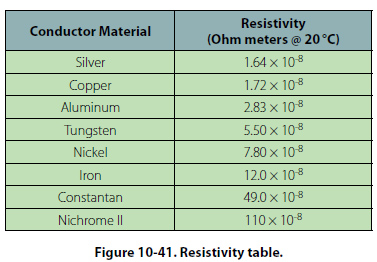 (http://avstop.com/ac/Aviation_Maintenance_Technician_Handbook_General/images/fig10-41.jpg)
(http://avstop.com/ac/Aviation_Maintenance_Technician_Handbook_General/images/fig10-41.jpg)
As you can see, silver has a lower resistivity than copper but because silver is the more expensive of the two, copper is the material of choice when making wires for both construction and classroom use.
Temperature
In addition to each material having a different resistivity. The same material at different temperatures may exhibit different resistivities. As materials heat up they become less facilitative of current flow. This is due to the fact that nuclei are moving faster at a sub-atomic level, when this occurs it creates more of a wall which is difficult for electrons to pass through. Because the nuclei do not move as much when the material is colder, it creates less of a "sheet" of nuclei for electrons to pass through.
Examples
Here are a few questions involving resistance and resistivity of differing difficulty.
Simple
Problem 1
An unknown ohmic resistor is attached to a 3V battery and the current is measured at 1 amp. Calculate the resistance of the unknown resistor.
Also, theoretically, if this resistor has a diameter of 0.03m, and length of 0.06m, what is its resistivity?
Solution
Using the equation [math]\displaystyle{ I = \frac{dV}{R} }[/math] we can substitute is 1 for I and 3 for dV leaving us with the equation [math]\displaystyle{ 1 = \frac{3}{R} }[/math]. Solving for R we come to the conclusion that the resistance must be 3 ohms.
To calculate resistivity, we put 7.06E-4m^2 for cross-sectional area, 0.06m for length and 3 ohms for resistance into our equation, getting [math]\displaystyle{ 3 = \frac{\rho 0.06}{7.06E-4} }[/math]. When you solve for resitivity, you get the answer of 0.0353 ohms/meter
Middling
Problem 2
A cylinder of an unknown material has a resistance of 30 ohms. Another cylinder made of the exact same material is twice as long and has a radius that is twice as large. What is the resistance of this cylinder?
Solution
Given the equation [math]\displaystyle{ R = \frac{\rho L}{A} }[/math] we know that when the length is doubled the resistance must also double. In addition we know that when the radius is doubled, the cross section area must go up by a factor of 4. This means that the resistance would go down by a factor of 1/4. Putting both of those facts together know that R2 = R1 * 2 * 1/4 or R2 = 15 ohms.
Difficult
Problem 3
A battery and resistor circuit is connected to a very sensitive ohmmeter and the two are then taken outside and left in the sun on a very hot day. What, if anything, will happen to its reading after being outside for a few minutes and why? Assume the battery is unaffected.
Solution
The current reading would be less than what it was while inside. Since the resistor circuit is outside, and hotter than usual the resistor will heat up. As discussed before, resistivity of a material goes up when it is hotter than normal, due to the increase motion of nuclei. The resistance goes up, but because the battery remains unaffected and holds the same amount of charge, the value of the current must go down (due to the inverse relationship of resistance and current). This is all based off of the very simple Ohms Law; [math]\displaystyle{ I = \frac{V}{R} }[/math]
Scope
Resistivity is a very important topic for all types of engineers, especially electrical and mechanical. It is important to know how circuits operate outside of laboratory conditions, and one thing that changes a lot in the real world is resistivity due to normal and extreme temperature conditions. Also, when building things like phones and other electronics, the total cost is always important. Though gold and silver may have very low resistivity, designers have to look at other metals that offer similar attributes but for lower costs. So overall, it is an important fundamental concept for engineers to understand the idea of resistance, but also play a large role in large scale manufacturing of different devices.
See also
Further reading
1. Matter and Interactions by Ruth Chabay and Bruce Sherwood
External links
Helpful Links
1. http://hyperphysics.phy-astr.gsu.edu/hbase/electric/resis.html
2. http://www.britannica.com/technology/resistance-electronics
3. http://www.cleanroom.byu.edu/Resistivities.phtml
4. http://www.nist.gov/data/PDFfiles/jpcrd155.pdf
5. http://www.regentsprep.org/Regents/physics/phys03/bresist/default.htm
Helpful Videos
1. https://www.youtube.com/watch?v=-PJcj1TCf_g
2. https://www.youtube.com/watch?v=J4Vq-xHqUo8
References
1. http://hyperphysics.phy-astr.gsu.edu/hbase/electric/resis.html
2. http://www.britannica.com/technology/resistance-electronics
3. http://www.nist.gov/data/PDFfiles/jpcrd155.pdf
4. http://www.regentsprep.org/Regents/physics/phys03/bresist/default.htm
5. http://forums.extremeoverclocking.com/showthread.php?p=4144637
